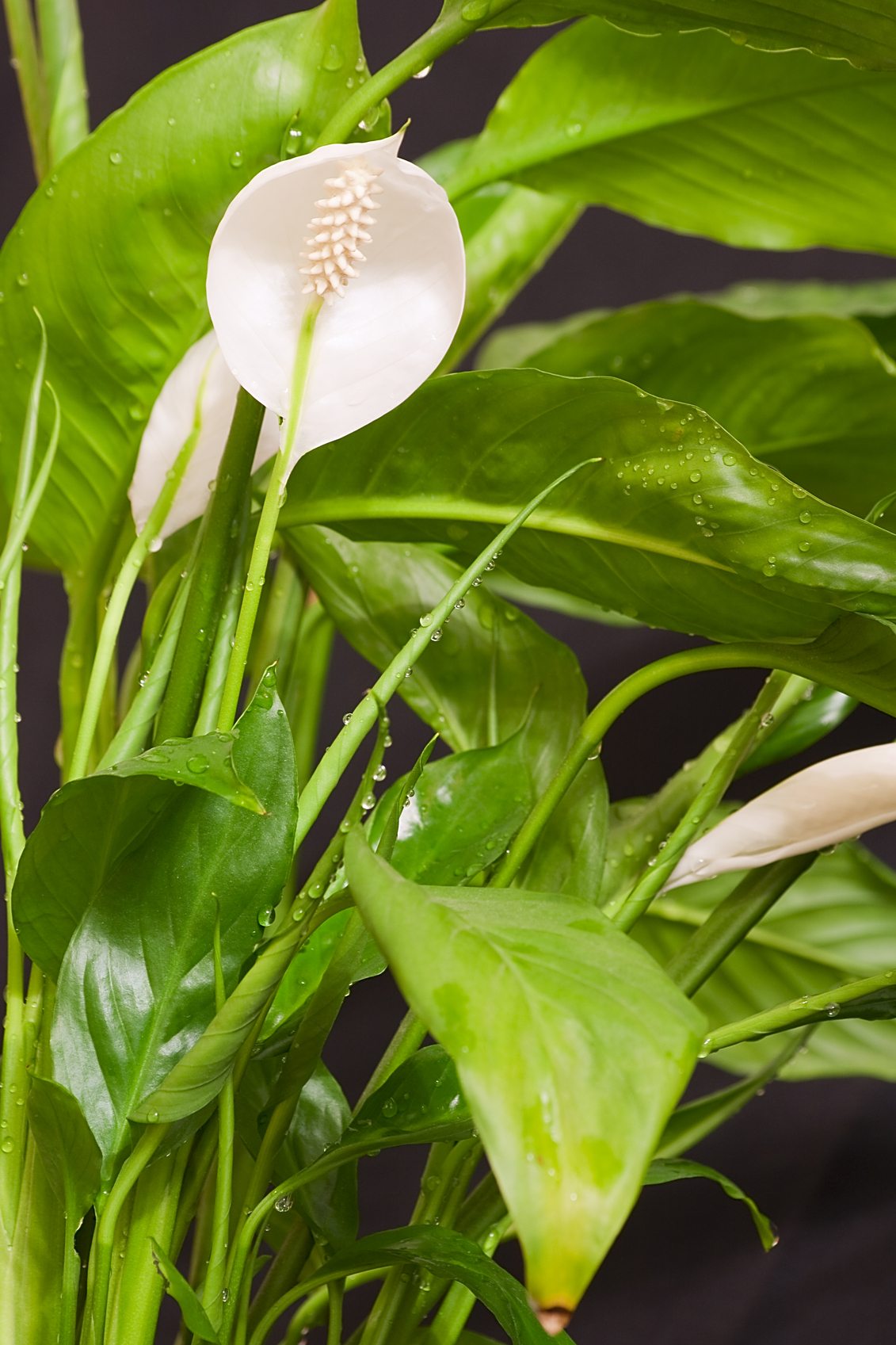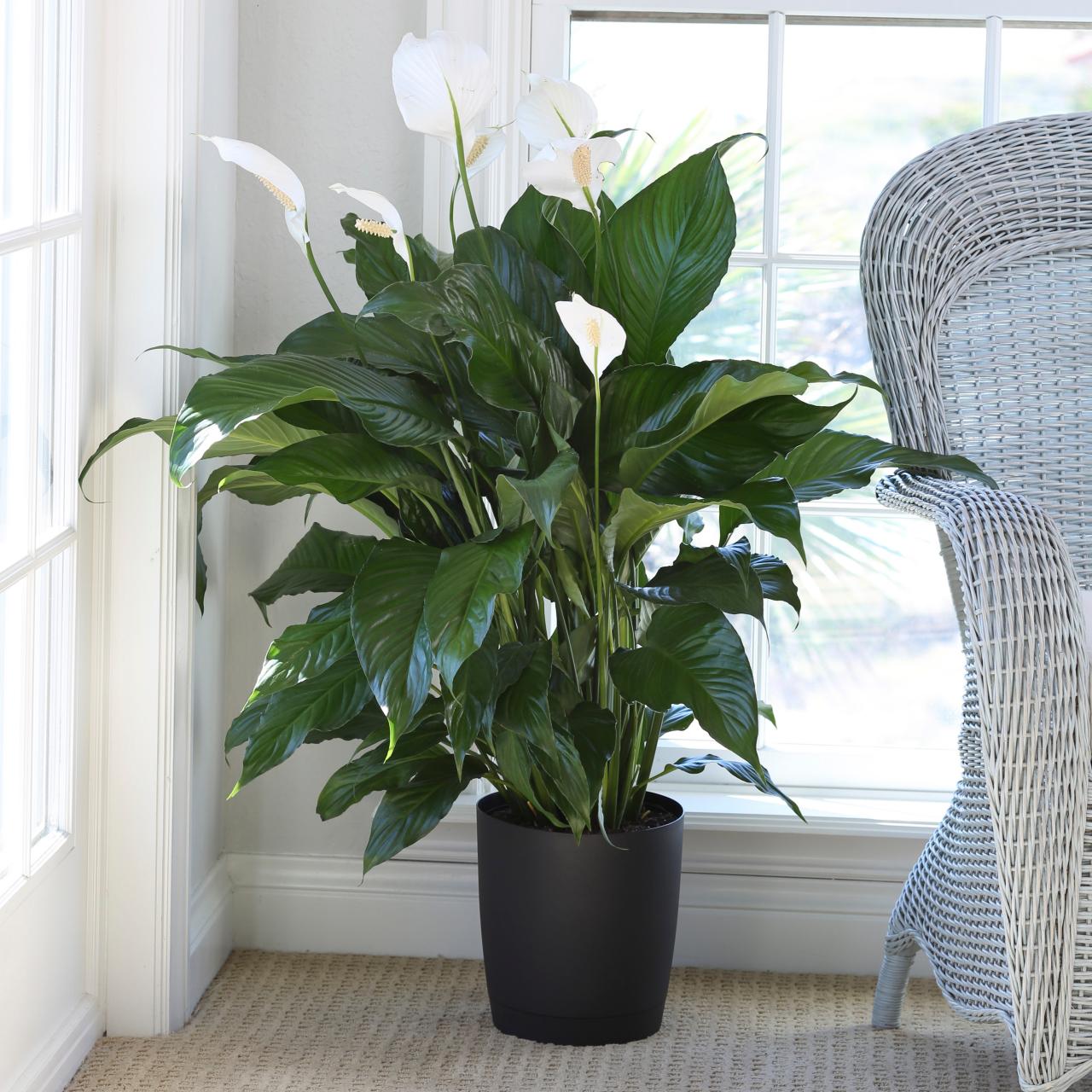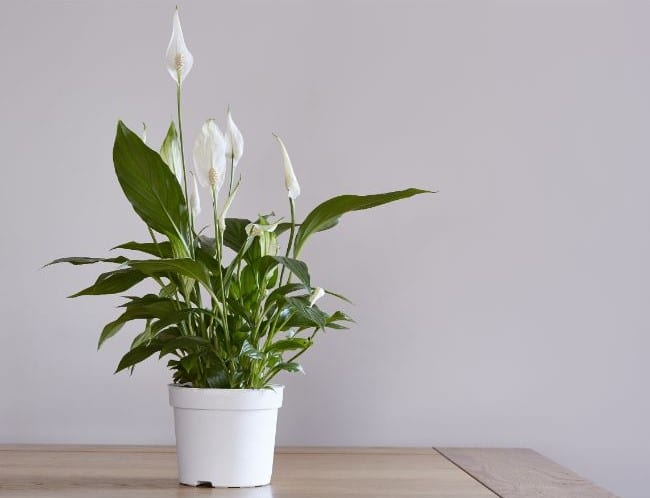Water peace lilies frequently with a deep soak since they need the soil to be evenly hydrated. To prevent the plant from drooping or developing root rot, a peace lily often only has to be watered once per week. To raise the humidity level, mist the leaves with water.
Continue reading for crucial watering best practices, including how frequently and how much to water and mist your peace lily in order to keep it healthy and avoid drooping or root rot.
Table of Contents
How Often to Water Peace Lilies
In its native Columbia, peace lilies (Spathiphyllum) are tropical plants that thrive in damp, moist soil with high humidity levels and brilliant indirect sunshine or dappled shade (rather then direct sun).
Peace lilies are especially prone to withering in our houses due to dryer air and underwatering because they are adapted to tropical settings with regular wetness.
Additionally, they may wilt and turn yellow as a result of excessive watering or more frequently when the roots are submerged in still water.
Replicating the watering conditions of the peace lily’s natural environment is crucial for healthy indoor growth.
Peace lilies need their soil to be evenly moist, therefore they normally need to be watered once a week with a good soak. In order to prevent the soil from being saturated and to achieve the ideal moisture balance, the soil’s surface should begin to feel a little dry in between watering sessions.
The air in our homes is frequently too dry for peace lilies, despite the fact that they grow very well there at room temperatures of 65°F to 75°F (18°C to 23°C) during the day and at least 50°F (10°C) at night. This needs to be stressed.
Air conditioning, forced air, and conventional currents from heat sources, which rob leaves of moisture and dry out pots more quickly, can exacerbate dry air.
To fix this, water your peace lily’s leaves at least once a week, if not more frequently, to produce a humid microclimate that resembles the humidity of its natural rainforest habitat.
In order to prevent your peace lily from drying out, the mist raises the relative humidity and decreases water loss from the leaves.
If the peace lily is not occasionally sprayed, the edges of the leaves may turn brown and the plant may droop in really dry surroundings.
When it comes to watering peace lilies, there are several additional considerations to make:
- the ambient temperature and humidity in your area.
- How big is your pot? (smaller pots can dry out much quicker).
- The ventilation in your house (draughts, open windows, air conditioning can all sap moisture from leaves).
- the soil’s ability to hold onto moisture.
Feel the soil to a depth of an inch to determine how frequently you should water your peace lily based on your particular conditions.
When the top inch of the soil still feels damp but the surface feels a little bit dry to the touch, it’s time to water.
In most circumstances, one per week is ideal; however, you should alter how frequently you water peace lilies to fit your particular conditions in order to avoid overwatering and drought, which can cause the leaves to turn yellow and wilt.
(Read my post on how to preserve yellow-leaved peace lilies.)
How to Tell Whether your Peace Lily is Under Watered or Over Watered
Contrary to popular belief, the signs of both an overwatered and an underwatered peace lily are basically the same.
- The most blatant and noticeable result of drought stress and over watering is drooping leaves.
- The leaves may turn yellow or even brown.
- If the humidity is too low, the leaf edges have a tendency to brown.
Feel the dirt at the bottom of the pot via the drainage hole to determine whether your peace lily is suffering from underwatering or overwatering.
Overwatering is the issue if the soil is soggy or damp, but it is safe to assume that underwatering and drought stress are to blame if the soil is comparatively dry.
The peace lily is likely to recover as it is a very hardy plant, however overwatering is typically more harmful than underwatering. Adjust your watering accordingly. (For additional details and to learn the answers, read my article on how to revive a dying peace lily.)
Important Peace Lily Watering Tips
A tropical plant that enjoys warmth is the peace lily. In its native Columbia, rain is frequently significantly warmer than your home’s tap water.
Cold water irrigation can cause minor shock to peace lilies because their roots, in particular, are sensitive to cold temperatures.
The ideal procedure is to wait until the water is roughly at room temperature in its container before watering.
Additionally, fluoride and chlorine in the water may cause the tips of peace lilies’ leaves to turn crispy and brown. If you let the water out overnight before watering your peace lily, the chlorine will evaporate.
Using filtered water or rainwater sometimes to water your peace lily can help reduce the effects of fluoride, which can accumulate and harm the plant.
To learn how to treat peace lilies with brown leaf tips, see my post.
How Often to Water a Peace Lily in Winter
Peace lilies can grow vigorously all year long and do not become dormant in the winter.
However, due to the shorter daylight hours and lower light intensity throughout the winter, growth does tend to slow down (peace lilies should grow in bright indirect light).
Cooler average temperatures can also help to minimize the demand for water by reducing evaporation and water loss from the leaves.
However, the indoor climate can change more during the winter because of artificial heat sources, which can cause the plant to dry out much more quickly than usual.
As a result, you might need to water and mist-spray the peace lily more frequently in the winter to combat the drying effects of forced air and radiator heating.
If you find the peace lily drying out too rapidly, increase your watering. Feel the top inch of the soil to check for moisture.
The peace lily’s drooping leaves can alert you if it is too dry. After a period of drought stress and dry soil, the plant benefits from a generous soak in water.
How Much to Water a Peace Lily
While there are many factors that might impact how frequently you water your peace lily, the recommended amount of water is constant.
Give your peace lily a generous bath, letting any extra water trickle out the pot’s base.
This guarantees that the soil is evenly saturated and that the water has permeated to the roots of your peace lily.
Giving your plants plenty of water also promotes healthy root growth.
If you water your plants too sparingly, only the top inch or two of soil will become wet, leaving the rest of the soil still largely dry and causing your peace lily to droop.
To mimic the environment of the peace lily’s original habitat, give the soil a good soak until it is moist.
Water Peace Lilies in Pots with Drainage holes in the Base
A smart approach to make sure the peace lily has received enough water is to water until the surplus water trickles out the pot’s base.
If your peace lily is in a pot without drainage holes, water will collect around the roots and cause stress, which can result in the plant drooping and turning yellow. Root rot can result from saturated soil, and it may be challenging to save the plant.
Even yet, extra water may still collect around the roots if
- Roots or compacted dirt can obstruct drainage holes. Check the drainage holes in the base if you see water draining slowly to make sure water can flow freely.
- Water can be kept from escaping with saucers, trays, and attractive outer pots. For use in the home, saucers, trays, and even beautiful outer pots are utilized to catch spilled water. Make sure to empty them frequently to avoid water collecting around the roots and leading to root rot.
Key Takeaways:
- To keep the plant hydrated, peace lilies often just need to be watered once each week. To ensure that the soil is evenly saturated, water each time with a generous soak. To enhance humidity and stop the peace lily from drying out, mist the leaves with water.
- To enable excess water to drain freely, plant peace lilies in containers with drainage holes at the base.
- The signs of both underwatering and overwatering include a drooping appearance and brown or yellowing of the leaf tips.
- To boost humidity and mimic the climate of the peace lily’s native rainforest, mist the leaves with water.
FAQ
How much water does a indoor peace lily need?
Water peace lilies frequently with a deep soak since they need the soil to be evenly hydrated. To prevent the plant from drooping or developing root rot, a peace lily often only has to be watered once per week. To raise the humidity level, mist the leaves with water.
How much water should you give a peace lily?
When the plant is thirsty, it may droop a little to let you know. If you keep track of when it typically begins to sag, you can arrange to water one day in advance. You can keep your peace lily moist in the summer by watering it roughly once a week and misting the leaves with water.
Can you water peace lily with tap water?
Watering peace lilies with tap water is acceptable, but fluoride and other potentially hazardous compounds can be removed by letting the water remain outside for a day or two. If water pours through the pot without stopping, the plant may be severely root-bound. Repot your peace lily as soon as you can if this is the situation.
Do peace lilies need sunlight?
Low to bright, indirect sunlight is suitable for growing peace lilies. They are the ideal plant to add color to a dim space or nook. Their leaves may burn and scorch under prolonged exposure to direct sunshine, which can also dry up their blossoms.
How do I know when my peace lily needs watering?
Watering Peace Lilies: A Guide. Although they require continually moist soil, peace lilies do not enjoy sitting in water that is still. Water the plant whenever the top inch of soil becomes dry, up until the point where the excess water begins to leak out of the bottom of the container. Reposition the pot in its saucer once the draining has finished.



